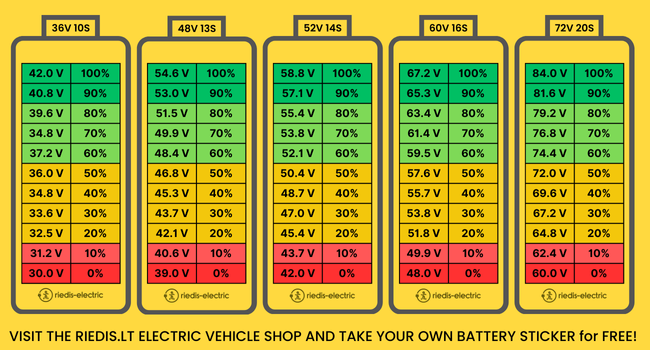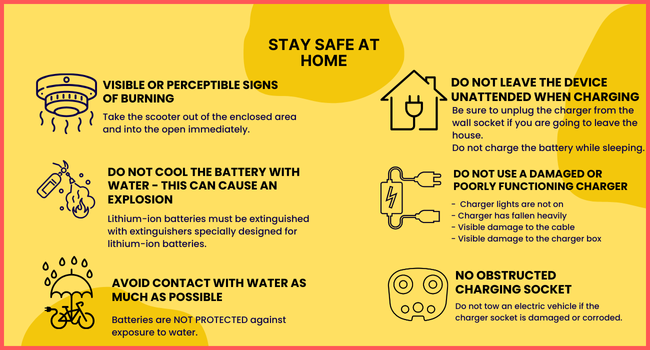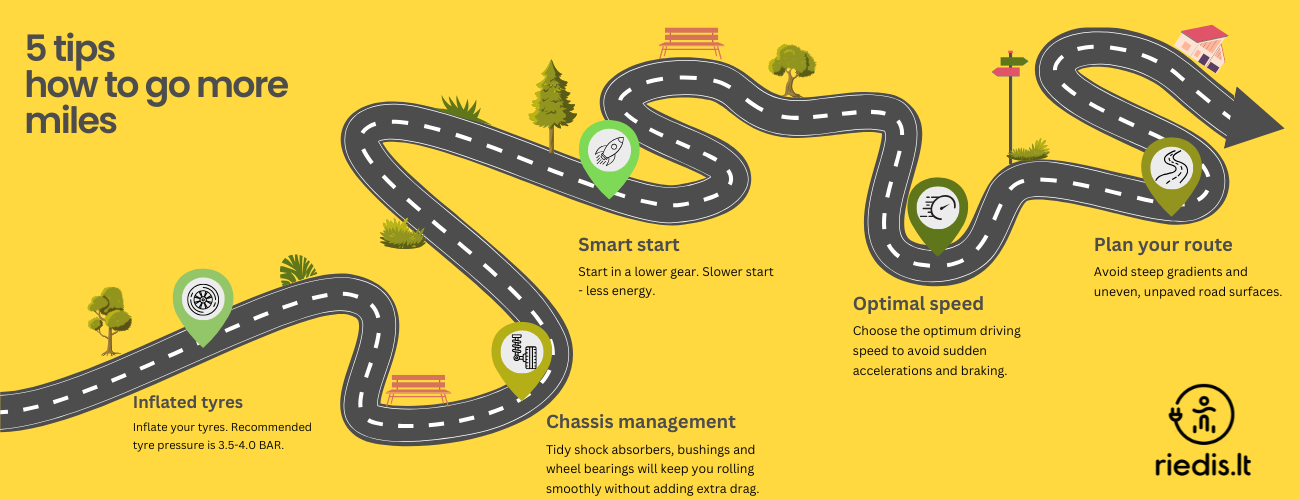The range of any electric bike, electric scooter, unicycle, scooter, electric scooter-cart or other electric vehicle always depends on:
• the electronics of the device;
• the type of battery;
• the capacity of the battery;
• the battery capacity; the battery voltages;
• the motors and the controller.
In our product descriptions, in the specification tables, the battery capacity is indicated in Ah (ampere hours) or Wh (watt hours). The higher the value, the greater the possible range.
The distance covered per charge is measured in the specifications:
• when the vehicle is new (battery capacity decreases over time, the natural process of battery wear and tear), resulting in reduced range;
• when the vehicle is 100% charged;
• on a smooth, paved surface without braking and acceleration;
• at a constant speed of ~20-25 km/h;
• with a load of 65-70 kg (driver's weight);
• at a temperature of ~20C;
• with tyres inflated to the correct pressure (the recommended pressure is indicated on the tyre sidewall);
• without wind resistance or other factors inhibiting the movement of the electric scooter or electric bicycle.

1. Do not rush to load the vehicle after the ride. Allow the vehicle to cool down, wait for about 1 hour. This is especially important if you have driven in cold temperatures or intensively;
2. Extend the life of the lithium-ion battery by limiting the charge and discharge to no more than 80% and no less than 20% of the battery. Charging the battery to 100% is not a critical error, but it is important not to keep it full for a long time.
3. Do not charge the scooter at night.
4. Do not leave the unit unattended while charging.
5. Do not leave one device charging.
6. Driving with less than 10% battery charge may result in voltage imbalance of the battery cells and may require servicing.

• Choose a storage area that is dry, well ventilated and free of moisture;
• keep out of direct sunlight;
• the temperature of the storage room should be between 15 and 25C;
• the battery charge should be 50-70% (3-4 dashes on the display);
• the storage room must be free of flammable objects or materials;
• keep away from small children or pets;
• do not store the battery in small, hot and enclosed places such as the boot of a car or other unventilated enclosed spaces.
The distance travelled by an electric vehicle depends on:
• the technical condition of the electric vehicle;
• Sudden starts - especially with higher loads and uphill gradients, which require more energy;
• load - the higher the load-weight, the more energy is needed to move the vehicle;
• Surface and terrain - on rough, hilly terrain, uneven viscous surfaces, resistance is advised and more energy is required.
• Driving style - abrupt increase in speed;
• weather conditions - in higher winds, there is resistance, so more energy is needed; in cold weather below +7C, batteries are needed, especially Li-Ion batteries distance travelled - decreases.
Lithium-ion (Li-on) batteries are widely used in electric bicycles, scooters, tricycles and ATVs because of their lightness, efficiency and durability. However, in order to keep the battery working for as long as possible, it is important to maintain it properly. Here are a few tips from the Riedis.lt team on how to do this:
1. Keep the battery properly charged
Regular charging: don't keep the battery completely discharged for long periods of time. It is best to charge the battery when it has about 20-30% of its capacity left.
Do not overcharge: Overcharging batteries can reduce their longevity. Most modern batteries have overcharge protection, but it is better to remove the battery when it is fully charged.
Avoid fast charging: Although some chargers offer fast charging, frequent use of this type of charging can shorten the life of the battery. Use normal charging mode.
2. Store at a suitable temperature
Optimum temperature range: Lithium-ion batteries work best at room temperature (10°C to 25°C). Keeping the battery at a higher or lower temperature may cause it to wear out faster.
Avoid cold and heat: Prolonged use or storage of the battery in extreme temperatures (below 0°C or above 40°C) can damage its capacity and cause permanent damage.
3. Keep the battery partially charged when not in use
If you plan to leave the bike unused for an extended period of time (e.g. during the winter), it is best to keep the battery charged to around 50%. This will help prevent negative chemical reactions inside the battery.
4. Avoid full discharge
A fully discharged battery, especially if stored for a long period of time, can be damaged and difficult to recharge. Use the bicycle in such a way that at least about 10-20% of the battery capacity remains.
5. Regular use
Li-on batteries lose their efficiency when left unused for long periods. Regular use of the bike (even for short distances) will help the battery to maintain its capacity for longer.
6. Protect against moisture
Water or moisture can damage not only the battery but also the electronics. After rain, wipe down the bike and battery to prevent corrosion.
7. Use the original charger
Use only the charger recommended or approved by the manufacturer. Using other chargers may not be compatible with your battery and may shorten its life or damage it.
8. Check the condition of your battery
Some electric bikes or batteries have the ability to check the status of the battery via mobile apps or controllers. Monitor the health of the battery and if you notice any unusual changes (such as a rapid decrease in capacity), contact a professional.
9. Store in a dry place
When you are not using your bicycle, store the battery in a cool, dry place. This will prevent corrosion and chemical reactions that can occur due to moisture.
Proper maintenance of the lithium-ion battery will not only prolong its life but also increase the overall efficiency of the electric micro-mobile vehicle.
 lt
lt
 en
en
 Electric bikes
Electric bikes  Manufacturers
Manufacturers  ENGWE
ENGWE  ECOBIKE
ECOBIKE  ADO
ADO  FIIDO
FIIDO  ONEMILE
ONEMILE  OOLTER
OOLTER  All electric bike
All electric bike  Electric scooters
Electric scooters  Brands
Brands  TEVERUN
TEVERUN  TEVERUN BLADE MINI
TEVERUN BLADE MINI  TEVERUN FIGHTER
TEVERUN FIGHTER  ENGWE
ENGWE  NAMI
NAMI  RIEDIS-ELECTRIC
RIEDIS-ELECTRIC  DUALTRON
DUALTRON  VSETT
VSETT  KAABO
KAABO  NEOLINE
NEOLINE  E-TWOW
E-TWOW  INMOTION
INMOTION  ULTRON
ULTRON  SXT
SXT  NIU
NIU  With seat
With seat  Big wheels
Big wheels  For kids
For kids  All goods
All goods  Most popular
Most popular  One motor scooters
One motor scooters  Two-wheel drive scooters
Two-wheel drive scooters  Mobility scooter 3-wheels
Mobility scooter 3-wheels  Three wheel scooters
Three wheel scooters  Four wheel scooters
Four wheel scooters  All mobility scooters
All mobility scooters  Mobility scooter 4-wheels
Mobility scooter 4-wheels  Electric wheelchairs
Electric wheelchairs  MINI electric cars
MINI electric cars  Electric mopeds
Electric mopeds  Brands
Brands  E-FUN
E-FUN  CITYCOCO (chioper)
CITYCOCO (chioper)  ELECTRORIDE
ELECTRORIDE  TALARIA
TALARIA  All electric mopeds
All electric mopeds  Need to registration
Need to registration  No need to registration
No need to registration  Up to €1500
Up to €1500  From €1500
From €1500  Electric unicycles (EUC)
Electric unicycles (EUC)  Brands
Brands  INMOTION
INMOTION  KING SONG
KING SONG  LEAPERKIM
LEAPERKIM  All euc\'s
All euc\'s  Parts
Parts  Parts for electric scooters
Parts for electric scooters  Tires
Tires  8\" - 8.5\" tires
8\" - 8.5\" tires  9\" tires
9\" tires  10\" tires
10\" tires  11\" tires
11\" tires  Other tires
Other tires  Tire valves, valve extensions
Tire valves, valve extensions  13\" tire
13\" tire  Inner Tubes
Inner Tubes  For 8\" - 8.5\" - 9\" tires
For 8\" - 8.5\" - 9\" tires  For 10\" tire
For 10\" tire  For 11\" tires
For 11\" tires  Other inner tubes
Other inner tubes  Brake System
Brake System  Brake Pads
Brake Pads  Brake Discs
Brake Discs  Brake Handles
Brake Handles  Brake calipers
Brake calipers  Brake Lines
Brake Lines  Hydraulic Brake Systems
Hydraulic Brake Systems  Drum Brake Systems
Drum Brake Systems  Body Parts, Forks, Suspension, Fenders
Body Parts, Forks, Suspension, Fenders  Fenders
Fenders  Suspensions
Suspensions  Seats
Seats  Kickstands
Kickstands  Folding Mechanism Parts
Folding Mechanism Parts  Covers and Caps
Covers and Caps  Anti-slip stickers / rubber mats
Anti-slip stickers / rubber mats  Frame/ Frame parts
Frame/ Frame parts  Forks
Forks  Electronics
Electronics  Switches
Switches  Displays
Displays  Cables and Connections
Cables and Connections  Batteries
Batteries  Controllers / Main Boards
Controllers / Main Boards  Chargers
Chargers  54.6V - For 48V Batteries
54.6V - For 48V Batteries  42V - For 36V Batteries
42V - For 36V Batteries  58.8V - For 52V Batteries
58.8V - For 52V Batteries  67.2V - For 60V Batteries
67.2V - For 60V Batteries  84V - For 72V Batteries
84V - For 72V Batteries  63V - 54V for batteries
63V - 54V for batteries  Throttles
Throttles  Fuses
Fuses  BMS / PCB boards
BMS / PCB boards  Headlights, Lamps, LED Lights
Headlights, Lamps, LED Lights  Headlights
Headlights  Lamps, LED Lights
Lamps, LED Lights  Battery cells
Battery cells  Battery connectors
Battery connectors  All Parts
All Parts  Tuning Parts
Tuning Parts  Steering handlebars
Steering handlebars  Handlebar Extenders
Handlebar Extenders  Handlebar Grips
Handlebar Grips  Handle Bars For Kids
Handle Bars For Kids  Handlebars
Handlebars  Steering Mechanism Parts
Steering Mechanism Parts  Motors and Wheel Hubs
Motors and Wheel Hubs  Motors
Motors  Wheels
Wheels  Bearings and Bearing Parts, Screws, Bushings, Gaskets, Nuts and Washers
Bearings and Bearing Parts, Screws, Bushings, Gaskets, Nuts and Washers  Bearings and bearing Parts
Bearings and bearing Parts  Screws
Screws  Įvorės
Įvorės  Bushings
Bushings  Gaskets
Gaskets  Nuts and Washers
Nuts and Washers  Tools and maintenance products
Tools and maintenance products  Tools
Tools  Care products
Care products  Cleaning products
Cleaning products  Lubricants
Lubricants  Screw glue
Screw glue  Sealants / Silicones
Sealants / Silicones  Parts for scooters by model
Parts for scooters by model  Pulse
Pulse  Xiaomi
Xiaomi  Inokim
Inokim  Ninebot
Ninebot  Zero
Zero  Kugoo
Kugoo  Dualtron
Dualtron  HX
HX  Kaabo
Kaabo  Neoline
Neoline  All Parts
All Parts  S8X riedis-electric
S8X riedis-electric  BIG CAT (CITYCOCO)
BIG CAT (CITYCOCO)  Ultron
Ultron  E-TWOW
E-TWOW  BOOSTER ES
BOOSTER ES  GT SPORT
GT SPORT  TEVERUN
TEVERUN  TEVERUN BLADE MINI
TEVERUN BLADE MINI  TEVERUN FIGHTER 11 /11+
TEVERUN FIGHTER 11 /11+  TEVERUN FIGHTER SUPREME
TEVERUN FIGHTER SUPREME  TEVERUN FIGHTER SUPREME 7260R
TEVERUN FIGHTER SUPREME 7260R  TEVERUN FIGHTER MINI
TEVERUN FIGHTER MINI  TEVERUN FIGHTER Q / BLADE Q
TEVERUN FIGHTER Q / BLADE Q  TEVERUN FIGHTER 10
TEVERUN FIGHTER 10  VSETT
VSETT  VSETT 8 8+
VSETT 8 8+  VSETT 9 9+
VSETT 9 9+  VSETT 10+
VSETT 10+  S10X
S10X  S10X riedis-electric
S10X riedis-electric  S10X BIRD LIMITED
S10X BIRD LIMITED  S10X PRO / S10X DUAL PRO
S10X PRO / S10X DUAL PRO  NIU
NIU  BLADE
BLADE  BLADE 10
BLADE 10  BLADE GT
BLADE GT  BLADE X
BLADE X  BLADE GT 2
BLADE GT 2  Inmotion
Inmotion  Electric bicycle parts
Electric bicycle parts  Tires
Tires  Inner Tubes
Inner Tubes  Electronics
Electronics  Controllers / Main Boards
Controllers / Main Boards  Displays
Displays  Sensors
Sensors  Cables / Wires
Cables / Wires  Batteries
Batteries  Motors
Motors  Throttles
Throttles  Chargers / Power supplier
Chargers / Power supplier  42V - 36V Batteries
42V - 36V Batteries  54.6V - 48V Batteries
54.6V - 48V Batteries  Headlights, Lamps, LED lights
Headlights, Lamps, LED lights  Headlights, Taillights
Headlights, Taillights  Brake system
Brake system  Body Parts, forks, suspension, fenders
Body Parts, forks, suspension, fenders  Bags and racks
Bags and racks  Bearings and Bearing Parts, Screws, Bushings, Gaskets, Nuts and Washers
Bearings and Bearing Parts, Screws, Bushings, Gaskets, Nuts and Washers  Drivetrain system parts
Drivetrain system parts  Electric unicycle parts
Electric unicycle parts  Tires
Tires  Tubes
Tubes  Electric bicycle parts by model
Electric bicycle parts by model  ADO
ADO  ADO A16 A16+ A16 XE
ADO A16 A16+ A16 XE  ADO A20 A20+ A20 XE
ADO A20 A20+ A20 XE  ADO A20F A20F+ A20F XE BEAST
ADO A20F A20F+ A20F XE BEAST  ADO Air 20 Air 20S
ADO Air 20 Air 20S  ADO A26 A26+ A26S XE
ADO A26 A26+ A26S XE  ADO D30 DECE 300 300C
ADO D30 DECE 300 300C  ENGWE
ENGWE  EP-2 PRO
EP-2 PRO  ENGINE PRO
ENGINE PRO  M20
M20  L20
L20  E26
E26  E26 ST
E26 ST  C20 PRO
C20 PRO  L20
L20  X20
X20  T14
T14  X24
X24  X26
X26  FIIDO
FIIDO  L3
L3  All parts
All parts  Tricycle / quadricycle parts
Tricycle / quadricycle parts  Accessories
Accessories  Safety gear
Safety gear  Bags / rear rack
Bags / rear rack  Phone Holders
Phone Holders  Mirrors
Mirrors  Horns
Horns  Dampers
Dampers  All accessories
All accessories  Locks
Locks  GPS trackers
GPS trackers  Headlights, lamps, LED lights
Headlights, lamps, LED lights  Headlights
Headlights  Covers
Covers  Electric pumps
Electric pumps  Alarms
Alarms  ENGWE electric bikes
ENGWE electric bikes  TEVERUN electric scooters
TEVERUN electric scooters  Discounts
Discounts  Brands
Brands  Service
Service  Insurance
Insurance  Blog
Blog  Business
Business  Video
Video 


 Items catalog
Items catalog
